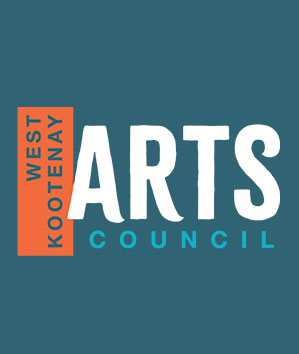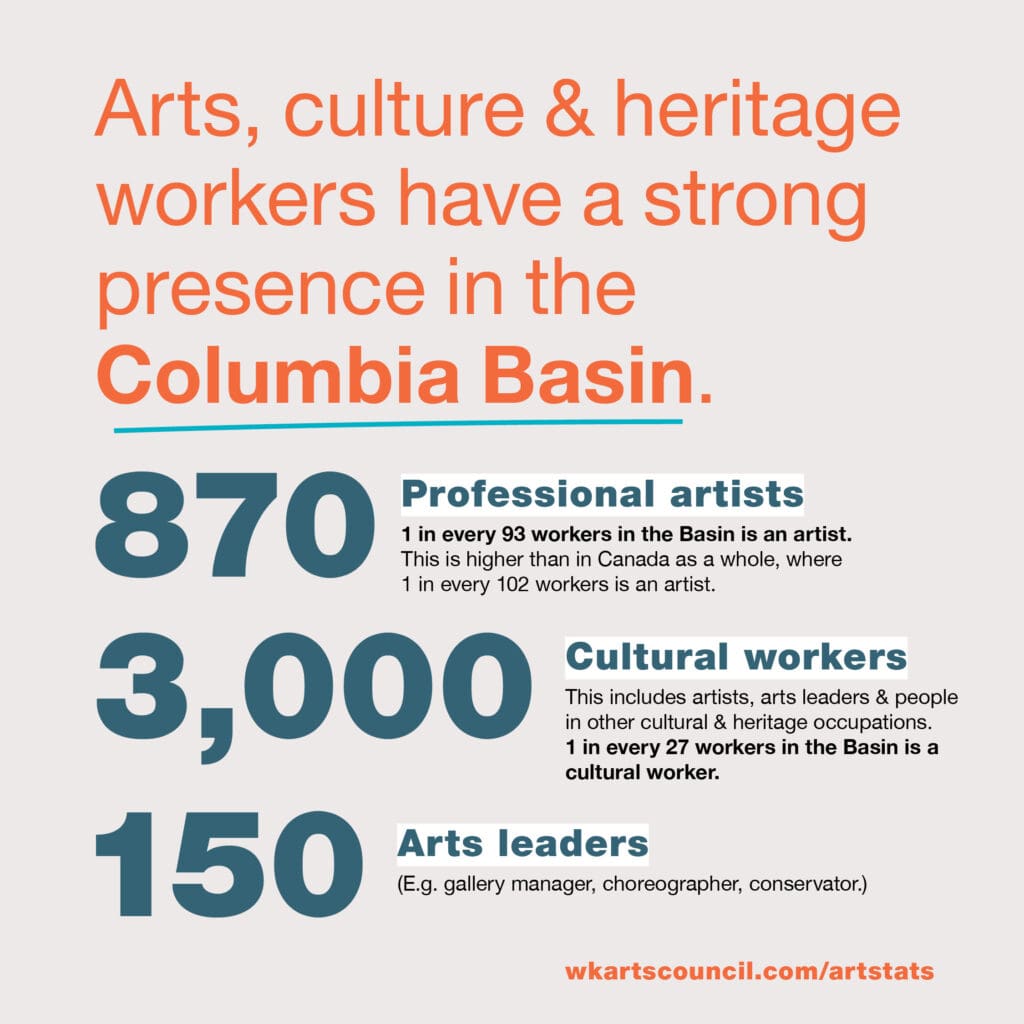
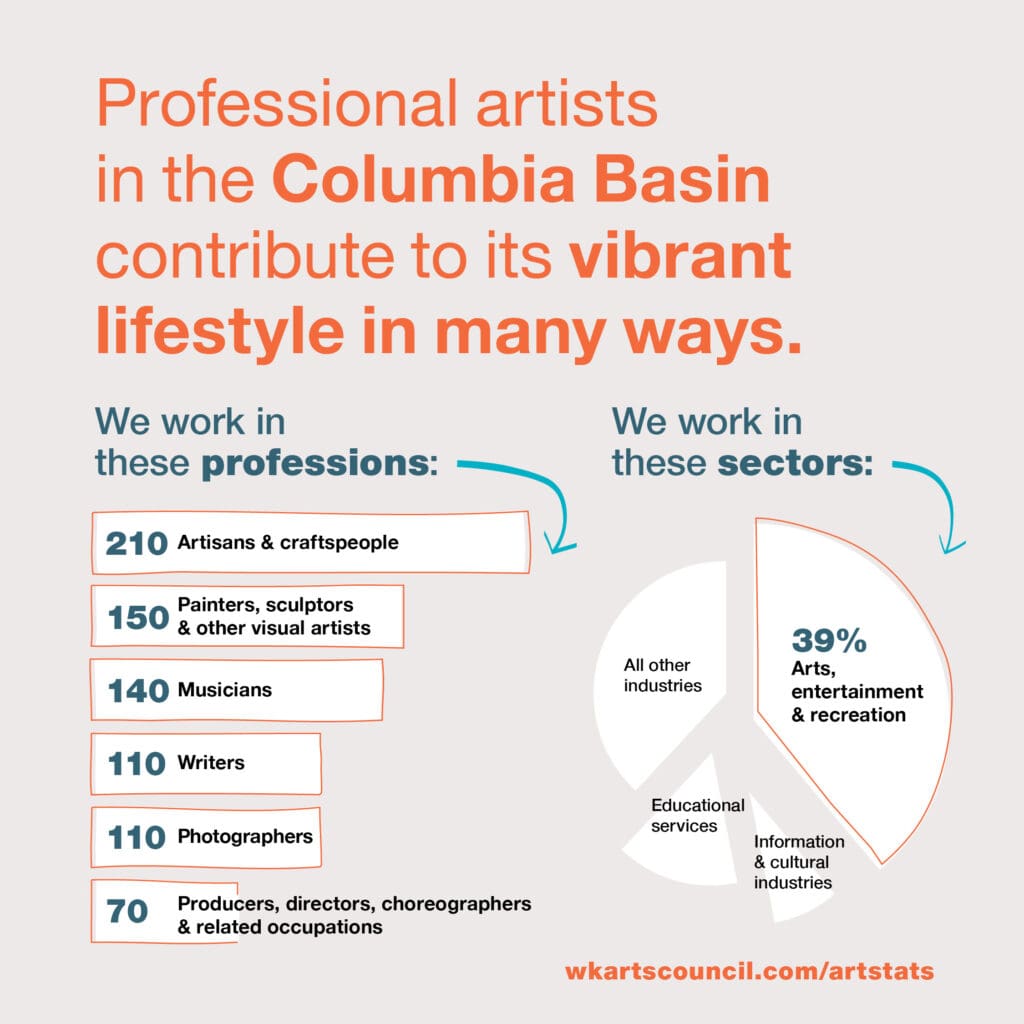
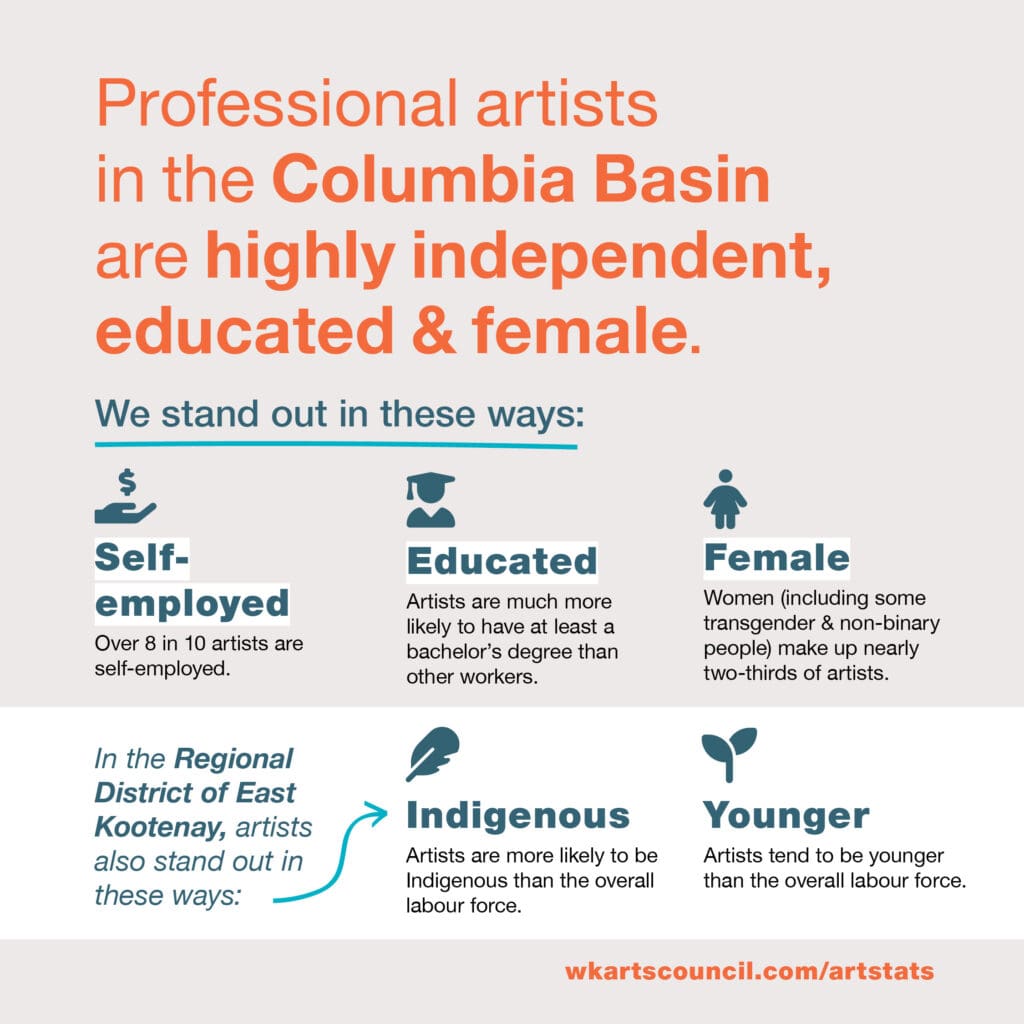
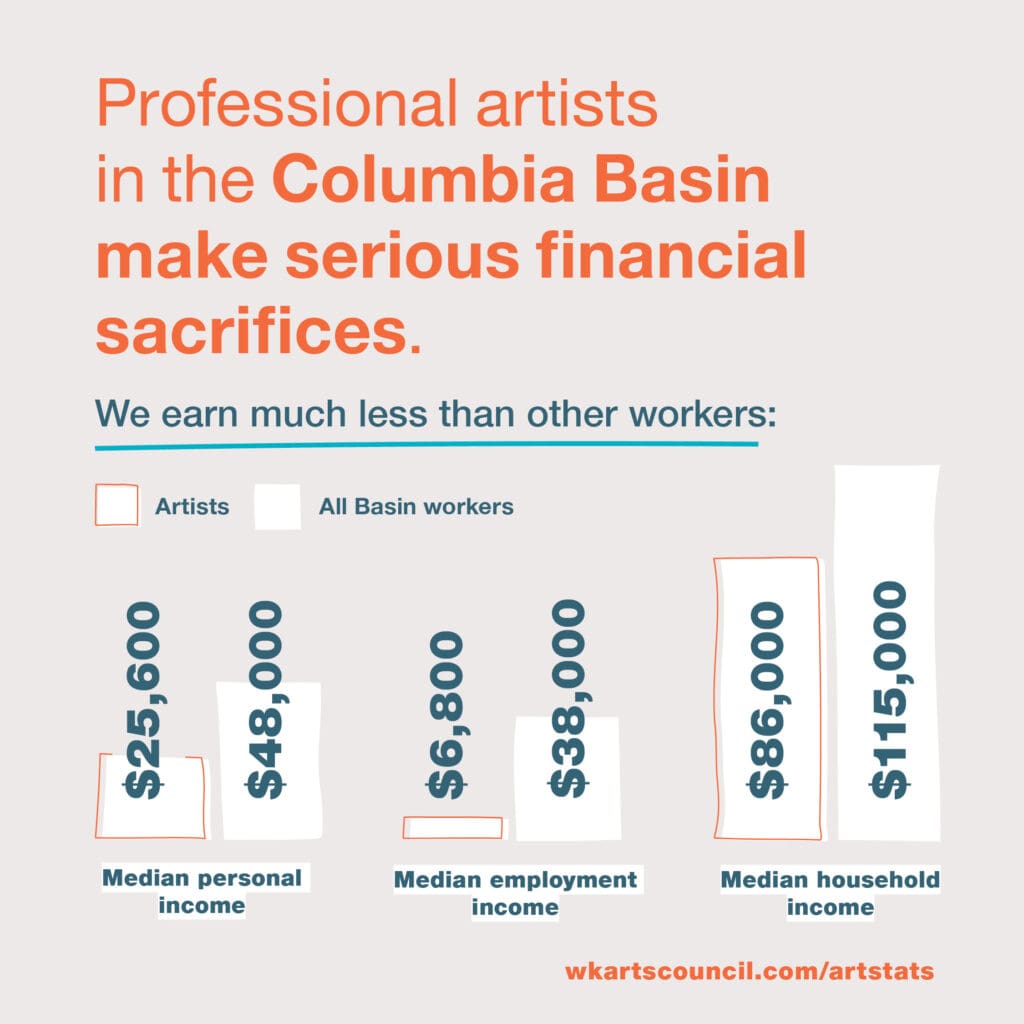
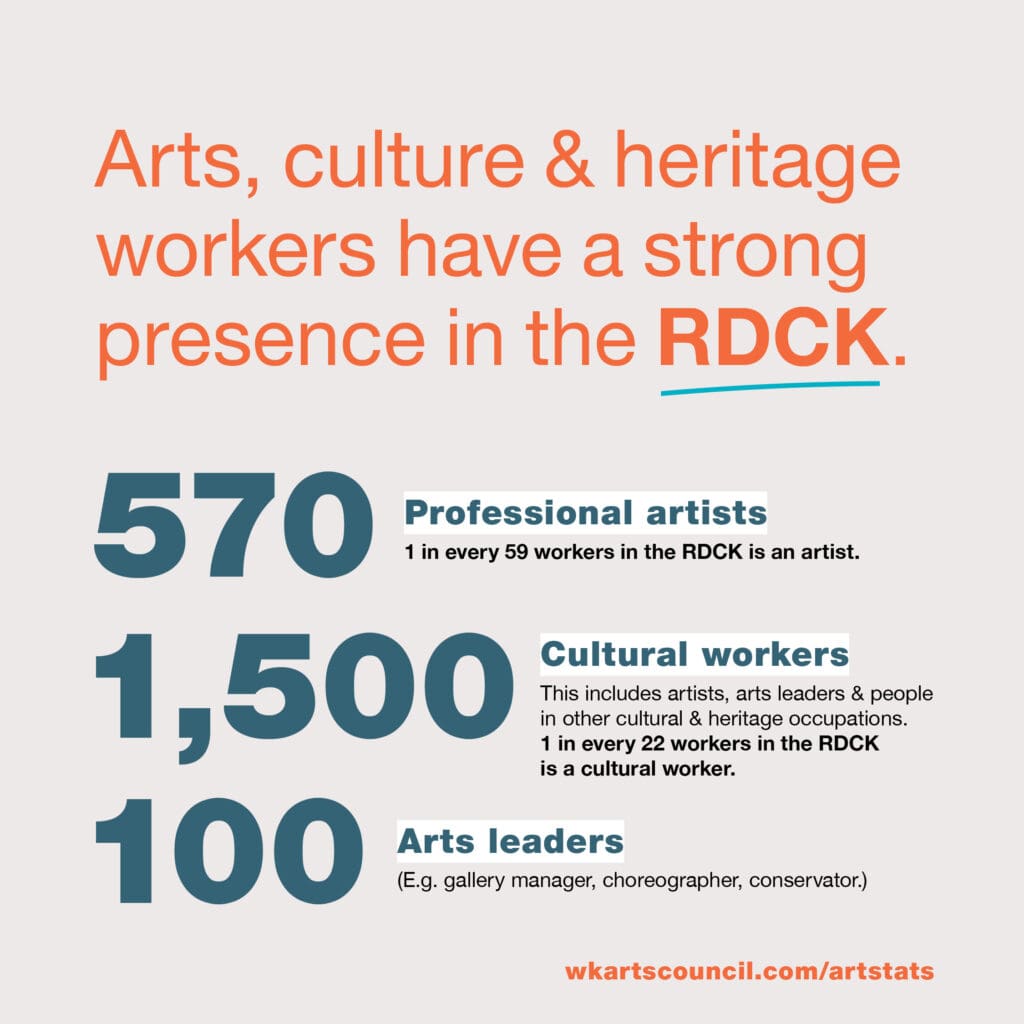
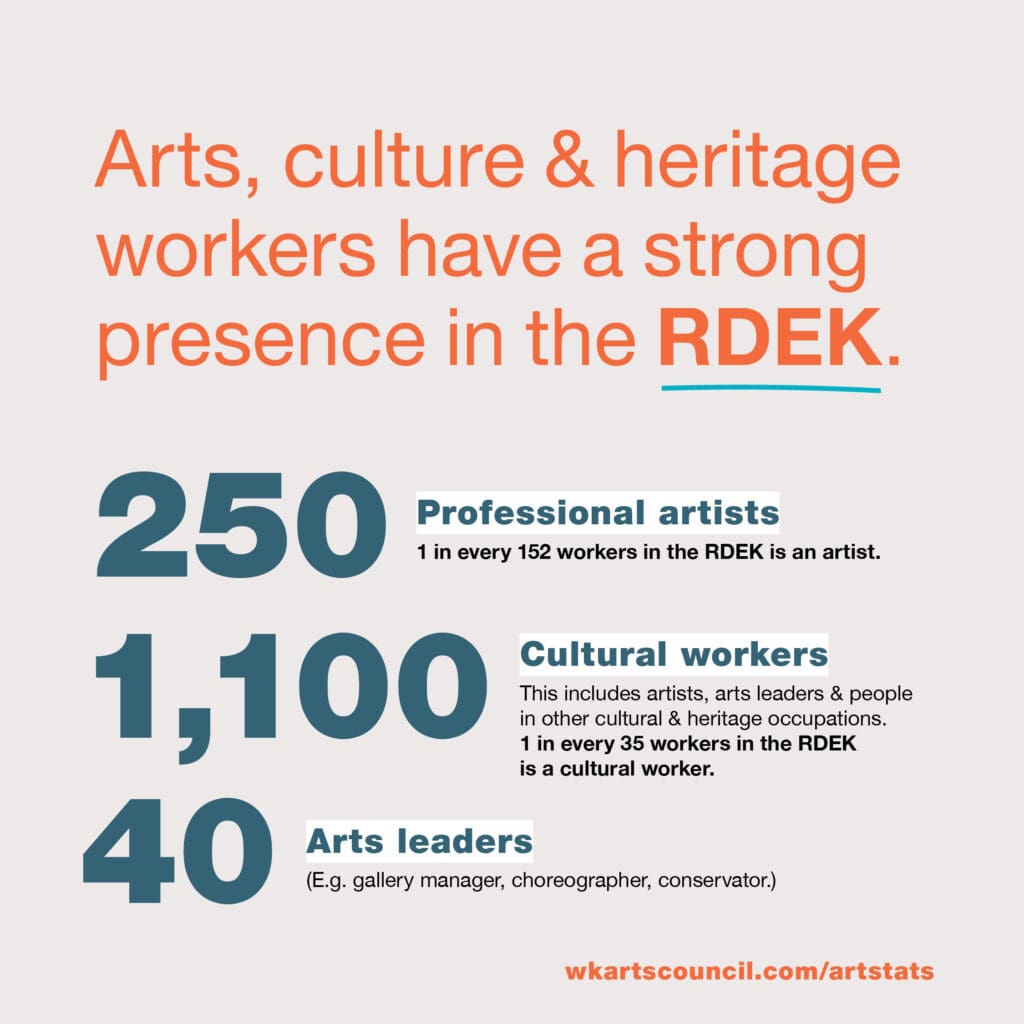

Click on an image to see a larger version.
Feel free to share these images widely. If you use them in social media, use the hashtag #BasinArtStats.
Note: The “Columbia Basin” stats do not include RDKB data.
1: The West Kootenay Regional Arts Council commissioned an article on the state of arts, culture and heritage in the Columbia Basin (including the regional districts of Central Kootenay and East Kootenay) from Hill Strategies, released in fall 2023.
- Read the article on this web page here.
- View the original article from Hill Strategies here.
- View the article as a pdf here.
2: WKRAC also commissioned an article on the state of arts, culture and heritage in the Regional District of Kootenay Boundary from Hill Strategies, released in fall 2024.
- Read the article on this web page here.
- View the original article from Hill Strategies here.
- View the article as a pdf here.
Thank you to the BC Arts Council for supporting this research.

Columbia Basin / RDCK / RDEK
Nearly 900 professional artists in B.C.’s Columbia Basin
The region has an above-average concentration of artists in its labour force
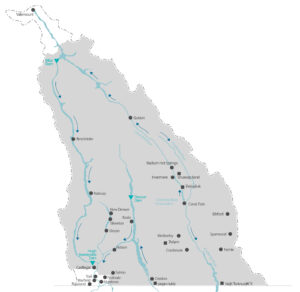
Based on custom data that Hill Strategies requested from Statistics Canada’s 2021 long-form census, this article examines the demographics, employment characteristics, and incomes of artists in British Columbia’s Columbia Basin, as well as summary information about workers in arts leadership occupations and all occupations in the arts, culture, and heritage (a category that includes artists and arts leaders).
The Columbia Basin is a distinct physical region in southeastern B.C., but its borders are not perfectly aligned with municipal geographies. Thanks to the support of the West Kootenay Regional Arts Council, as much of this region as possible is examined in this article, with some limitations due to the need to define the Basin based on municipal borders (to be consistent with Statistics Canada datasets). In this article, the Columbia Basin comprises all of the Regional District of Central Kootenay, all of the Regional District of East Kootenay, and a portion of the Columbia Shuswap Regional District. Separate data are provided here for the two Regional Districts that are fully contained within the Columbia Basin.
Details of the occupational categories and other notes regarding methods are provided at the end of the article.
Hill Strategies Research retained full editorial control of the content of the article.
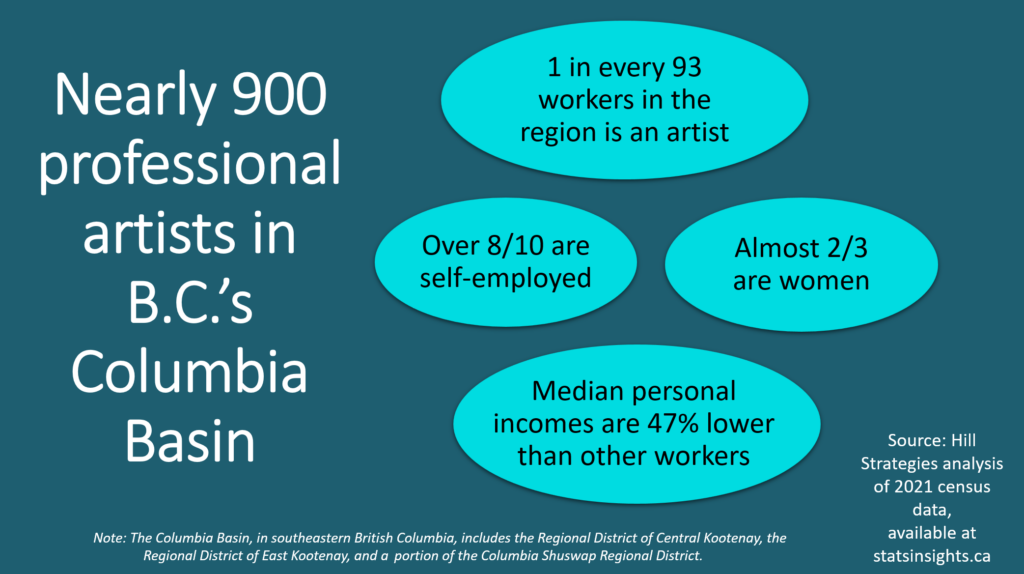
Provincial and national context: Artists, arts leaders, and all cultural workers
There are 39,700 professional artists who reside in B.C., representing 20% of the 202,900 artists in Canada. As a percentage of the overall labour force, artists account for 1.4% in B.C., the highest percentage among the provinces and well above the national average (1.0%). In B.C., one in every 72 workers is an artist, compared with one in every 102 Canadian workers. (Articles related to B.C. artists and Canadian artists are available. The Canadian post provides a list of the 10 artist occupation groups.)
56,200 Canadians, including 10,100 British Columbians, work in five occupation groups that are classified as arts leaders. B.C. accounts for 18% of Canada’s arts leaders, higher than the province’s share of all workers (14%). For more information on the occupation groups included as arts leaders, please see this Canada-wide article. Two of the arts leadership occupations (those including conductors and composers as well as producers, directors, and choreographers) are also included as artists. As such, the number of arts leadership workers should not be added to the number of artists in any jurisdiction.
The broadest analysis relates to the 154,800 British Columbians and 914,000 Canadians who work in arts, culture, and heritage occupations. These workers represent 5.4% of B.C.’s labour force, the highest proportion among the provinces and well above the national average of 4.4%. One in every 18 B.C. workers and every 23 Canadian workers has a cultural occupation. The 52 occupation groups in this category include the 10 artist occupation groups as well as the 5 arts leadership occupation groups, other cultural occupations (e.g., graphic designers, print operators, editors, translators, architects, and professionals in fundraising, advertising, marketing, and public relations), and heritage occupations (e.g., librarians, curators, and archivists).
870 professional artists in the Columbia Basin
There are 870 professional artists in the Columbia Basin, including 570 in the Regional District of Central Kootenay (hereafter “Central Kootenay”) and 250 in the Regional District of East Kootenay (hereafter “East Kootenay”). The other 50 artists in the Columbia Basin live in part of the Columbia Shuswap Regional District, north of Central and East Kootenay.
As a percentage of the regional labour force, artists represent:
- 1.1% of the Columbia Basin’s overall labour force (slightly above the national average of 1.0%)
- 1.7% of the overall labour force in Central Kootenay (above the provincial average of 1.4%)
- 0.7% of the overall labour force in East Kootenay
Examined differently, the artist statistics mean that:
- 1 in every 93 workers in the Columbia Basin is a professional artist
- 1 in every 59 workers in Central Kootenay is a professional artist
- 1 in every 152 workers in East Kootenay is a professional artist

Artists in the Columbia Basin have a very high self-employment rate
Table 1 shows the percentage of artists in each of the three regions with certain demographic characteristics, with comparisons to all workers in each region’s labour force. Some highlights from the table:
- In each region, over 8 in 10 artists are self-employed. The self-employment rate among artists is many times higher than the rate among all regional workers and is higher than the rate among all B.C. artists (72%).
- Artists in each region are much more likely to have at least a bachelor’s degree than other local workers.
- Women (including some transgender and non-binary people) make up nearly two-thirds of artists in all three regions. Women are a much higher percentage of artists in these regions (63% or 64%) than in B.C. as a whole (55%).
- In East Kootenay, artists are more likely to be Indigenous than the overall labour force. In the other two regions, artists are about as likely as the overall labour force to be Indigenous. Indigenous Peoples are a higher percentage of artists in these regions (between 6% and 10%) than in B.C. as a whole (4.5%).
- In East Kootenay, artists tend to be younger than the overall labour force. In the other two regions, artists are about as likely as the overall labour force to be 55 or older.


Professional artists in the Columbia Basin had very low median incomes in 2020
The following statistics and graph relate to median personal income, which includes all sources of income for individuals, such as employment income, net revenue from self-employment, pandemic supports, rental income, investment income, and others.
As the graph shows, the median personal income of all artists in the Columbia Basin is $25,600, which is 47% less than the median of all local workers ($48,000).
In Central Kootenay, the median personal income of artists is $27,200, or 38% less than all local workers ($44,000).
In East Kootenay, artists’ median personal incomes are $21,800, which is 58% less than the median of all local workers ($51,600).
In comparison, the median personal income of the nearly 40,000 professional artists in all of B.C. is $29,400, which is 40% less than the median of all workers in the province ($49,200).


Artists in the Columbia Basin make significant financial sacrifices to practise their craft
Table 2 provides two other measurements of the incomes of artists and all workers in the Columbia Basin, Central Kootenay, and East Kootenay. Employment income shows the work-related earnings (including net self-employment income), and household income provides a measure of workers’ family situations.
These statistics indicate that the Columbia Basin’s artists make significant financial sacrifices to practise their craft, especially in 2020, when the median employment income of artists was roughly one-fifth of the median in overall labour force (shown in the table as -80% or more). This has an impact on artists’ median personal income (47% lower than the overall labour force) and on their total household income (25% lower than the overall labour force).
East Kootenay artists have lower employment and personal incomes than artists in Central Kootenay and all artists in the Columbia Basin. (It was shown above that East Kootenay artists also tend to be younger than their counterparts in other areas of the Columbia Basin.) However, East Kootenay artists appear to have significant support from other family members, as their household incomes are higher than those of artists in Central Kootenay and the Columbia Basin.

Professional artists by occupation and industry
Across B.C., musicians are the largest artist occupation group. This is not the case in the Columbia Basin, however, where craftspeople are the largest artist occupation. Painters and other visual artists are the second largest artist occupation in the Basin.
Forty people is the threshold of reliability for census counts. With 250 artists divided into 10 occupation groups, the counts by occupation group are not reliable for East Kootenay. In the Columbia Basin and Central Kootenay, there are fewer than 40 residents in four artist occupation groups: actors, comedians & circus performers; conductors, composers & arrangers; dancers; and other performers.
From most to least common in the Columbia Basin as a whole, the occupation groups with at least 40 artists are:
- Artisans & craftspeople: 210 in the Columbia Basin (24% of the region’s artists), including 150 in Central Kootenay (27%).
- Painters, sculptors & other visual artists: 150 in the Columbia Basin (17%), including 110 in Central Kootenay (19%).
- Musicians: 140 in the Columbia Basin (16%), including 70 in Central Kootenay (13%).
- Writers: 110 in the Columbia Basin (13%), including 90 in Central Kootenay (16%).
- Photographers: 110 in the Columbia Basin (13%), including 50 in Central Kootenay (9%).
- Producers, directors, choreographers & related occupations: 70 in the Columbia Basin (8%), including 50 in Central Kootenay (8%).
Consistent with the very high self-employment rate of artists in the region, the largest industry sector is arts, entertainment, and recreation, which employs 39% of them. This industry sector includes a category for “independent artists, writers, and performers”.
The next-largest industry sectors are educational services (where 15% of Columbia Basin artists are employed) and information and cultural industries (8%).
Many Columbia Basin artists work in other sectors of the economy: all other industries (excluding the three largest ones) employ 39% of artists. This very high percentage is related to the region’s high proportion of craftspeople, many of whom are classified in industries such as manufacturing and retail trade that are outside of the arts and cultural industries.
In Central Kootenay and East Kootenay, the proportions by industry sector are similar to the overall Columbia Basin, with one exception. East Kootenay artists are somewhat more likely than other artists in the region to be employed in educational services and slightly less likely to be in arts, entertainment, and recreation.
Median personal income by artist occupation group
Two of the most common artist occupation groups in the Columbia Basin – craftspeople and painters – have the lowest median incomes, as shown in the graph below. In general, artists in Central Kootenay tend to have higher median incomes than in the Columbia Basin as a whole. (Readers should keep in mind that artists in Central Kootenay comprise a relatively large proportion of all artists in the Columbia Basin.)

150 arts leaders reside in the Columbia Basin
150 Columbia Basin residents work in the five occupation groups that are classified as arts leaders, including 100 residents of Central Kootenay and 40 residents of East Kootenay.
A breakdown by occupation is not possible, because there are fewer than 40 workers in each of the five occupation groups:
- Library, archive, museum & art gallery managers
- Managers in publishing, motion pictures, broadcasting & performing arts
- Producers, directors, choreographers & related occupations
- Conductors, composers & arrangers
- Conservators & curators
In keeping with their senior positions, arts leaders tend to have relatively high incomes. However, this is not the case in the Columbia Basin. In 2020, a typical arts leader in the Columbia Basin had:
- Employment income of $27,800, 27% less than all Columbia Basin workers ($38,000)
- Total personal income of $32,000, 33% less than all workers in the region ($48,000)
- Household income of $99,000, 14% less than all workers in the region ($115,000)
3,000 cultural workers in the Columbia Basin
There are 3,000 workers in arts, culture, and heritage occupations in the Columbia Basin, representing 3.7% of the 80,600 people in the regional labour force, below the provincial average (5.4%) but closer to the national average (4.4%). One in every 27 workers in the Columbia Basin has a cultural occupation.
In 2020, a typical cultural worker in the Columbia Basin had:
- Employment income of $24,200, 36% less than all Columbia Basin workers ($38,000)
- Total personal income of $36,800, 23% less than all workers in the region ($48,000)
- Household income of $99,000, 14% less than all workers in the region ($115,000)
Just over 1,500 cultural workers reside in Central Kootenay. Cultural workers account for 4.6% of the 33,200 people in the district’s labour force. One in every 22 workers in Central Kootenay has a cultural occupation.
Central Kootenay’s cultural workers had the following median income levels in 2020:
- Employment income of $19,200, 43% less than all workers in Central Kootenay ($33,600)
- Total personal income of $32,000, 27% less than all workers in the district ($44,000)
- Household income of $95,000, 8% less than all workers in the district ($103,000)
1,100 residents of East Kootenay work in cultural occupations, representing 2.9% of the 37,100 people in the district’s labour force. One in every 35 workers in East Kootenay has a cultural occupation.
The median income levels of cultural workers in East Kootenay were as follows in 2020:
- Employment income of $29,600, 30% less than all workers in East Kootenay ($42,000)
- Total personal income of $42,000, 19% less than all workers in the district ($51,600)
- Household income of $101,000, 19% less than all workers in the district ($124,000)
Notes regarding methods and occupational groupings
The above analysis relates to professional workers, but with a very specific concept of professional. The census data on occupations include people who worked more hours as an artist than at any other occupation between May 1 and 8, 2021, plus people who were not in the labour force at that time but had worked more as an artist than at another occupation between January of 2020 and May of 2021. Part-time artists who spent more time at another occupation in May of 2021 would be classified in the other occupation. (The same would be true of workers in arts leadership occupations and all cultural occupations.)
The occupational perspective counts people who work across the economy, as long as they are classified into one of 10 artist occupation groups, 5 arts leadership occupation groups, or 52 cultural occupation groups. Details about the occupation groups included in each of the categories is available in a recent article, which also outlined the methods behind choosing the 52 cultural occupation groups. Another article highlighted some strengths and limitations of the census for counting artists and cultural workers.
To ensure confidentiality and data reliability, no estimates of fewer than 40 people are presented in this article.
The challenging context of the pandemic in the spring of 2021 is important to keep in mind when interpreting census data on artists, which were collected in May of 2021. Income data from the census relate to the 2020 calendar year.
RDKB
Statistical profile of artists in B.C.’s Regional District of Kootenay Boundary
Kootenay Boundary has 120 professional artists, a large majority of whom are self-employed
Based on custom data that Hill Strategies requested from Statistics Canada’s 2021 long-form census, this article examines the demographics, employment characteristics, and incomes of artists who reside in the Regional District of Kootenay Boundary in British Columbia. Also included is brief information about workers in arts leadership occupations and all workers in the arts, culture, and heritage (a group that includes artists and arts leaders).
The article is made possible with the support of the West Kootenay Arts Council. An analysis of artists in neighbouring areas (the Columbia Basin, including the Regional District of Central Kootenay and the Regional District of East Kootenay) was prepared in 2023.
Hill Strategies Research retained editorial control of the content.
Provincial and national context, plus key definitions
There are 39,700 professional artists who reside in B.C., representing 20% of the 202,900 artists in Canada. As a percentage of the overall labour force, artists account for 1.4% in B.C., the highest percentage among the provinces and well above the national average (1.0%). In B.C., one in every 72 workers is an artist, compared with one in every 102 Canadian workers. (Articles related to B.C. artists and Canadian artists are available. The Canadian post provides a list of the 10 artist occupation groups.)
56,200 Canadians, including 10,100 British Columbians, work in five occupation groups that are classified as arts leaders. B.C. accounts for 18% of Canada’s arts leaders, higher than the province’s share of all workers (14%). For more information on the occupation groups included as arts leaders, please see this Canada-wide article. Two of the arts leadership occupations (those including conductors and composers as well as producers, directors, and choreographers) are also included as artists. As such, the number of arts leadership workers should not be added to the number of artists in any jurisdiction.
The broadest analysis relates to the 154,800 British Columbians and 914,000 Canadians who work in arts, culture, and heritage occupations. These workers represent 5.4% of B.C.’s labour force, the highest proportion among the provinces and well above the national average of 4.4%. One in every 18 B.C. workers and every 23 Canadian workers has a cultural occupation.
The 52 occupation groups in this category include the 10 artist occupation groups as well as the 5 arts leadership occupation groups, other cultural occupations (e.g., graphic designers, print operators, editors, translators, architects, and professionals in fundraising, advertising, marketing, and public relations), and heritage occupations (e.g., librarians, curators, and archivists).
Further information about each of the categories is available, as are the methods behind choosing the 52 cultural occupation groups. Contextual information about the strengths and limitations of the census for counting artists and cultural workers is also available.
Census data relate to a very specific definition of professional workers: people who worked more hours as an artist than at any other occupation between May 1 and 8, 2021, plus people who were not in the labour force at that time but had worked more as an artist than at another occupation between January of 2020 and May of 2021. Part-time artists who spent more time at another occupation in May of 2021 would be classified in the other occupation. (The same would be true of workers in arts leadership occupations and all cultural occupations.)
The prevalence of “gig work” and the often-atypical nature of artists’ workflows can make it challenging for official statistics to count artists as artists. As such, census estimates of the number of artists might be low.
120 professional artists in Kootenay Boundary
There are 120 professional artists in the Regional District of Kootenay Boundary (hereafter “Kootenay Boundary”). Artists represent 1.0% of all workers in Kootenay Boundary, which is equal to the national average (1.0%) but below the provincial average (1.4%). Examined differently, these statistics mean that 1 in every 93 workers in Kootenay Boundary is a professional artist.
In comparison, there are 870 professional artists in the Columbia Basin, which is adjacent to Kootenay Boundary. The Columbia Basin total includes 570 artists in the Regional District of Central Kootenay and 250 in the Regional District of East Kootenay. In these jurisdictions, artists represent:
- 0.7% of the overall labour force in East Kootenay (1 in every 152 workers)
- 1.1% of the Columbia Basin’s overall labour force (equivalent to 1 in every 93 workers in the Columbia Basin)
- 1.7% of the overall labour force in Central Kootenay (1 in every 59 workers)

Demographic and employment characteristics of artists in Kootenay Boundary
Among the 120 artists in Kootenay Boundary:
- 83% are self-employed, many times higher than the self-employment rate of all workers in Kootenay Boundary (18%) and much higher than the rate among all B.C. artists (72%).
- 42% are women (potentially including some non-binary individuals), lower than the percentage of all workers in Kootenay Boundary (47%) and much lower than all B.C. artists (55%).
- 38% have a bachelor’s degree or higher, almost twice the proportion of all workers in Kootenay Boundary (20%) but similar to that of all B.C. artists (43%).
- To ensure confidentiality and data reliability, no estimates of fewer than 40 people are presented in this article. There are fewer than 40 artists in many other demographic categories, and the data for them are not presented here. This includes the number of local artists who are Indigenous, members of a racialized group, immigrants to Canada, or in different age ranges.

Professional artists in Kootenay Boundary had very low median incomes in 2020
The following statistics and graph relate to median personal income, which includes all sources of income for individuals, such as employment income, net revenue from self-employment, pandemic supports, rental income, investment income, and others.
As shown in the graph, the median personal income of artists in Kootenay Boundary is $24,800, which is 48% less than the median of all local workers ($48,000).
In comparison, the median personal income of the roughly 40,000 professional artists in all of B.C. is $29,400, which is 40% less than the median of all workers in the province ($49,200).


Artists in Kootenay Boundary make significant financial sacrifices to practise their craft
This section provides two other measurements of the incomes of artists and all workers in Kootenay Boundary. Employment income shows the work-related earnings (including net self-employment income), and household income provides a measure of workers’ family situations.
These statistics indicate that Kootenay Boundary’s artists make significant financial sacrifices to practise their craft, especially in 2020, when the median employment income of artists was only $10,000, which is roughly one-quarter of the median in the local labour force ($38,400). This has an impact on artists’ median personal income (48% lower than the overall labour force, as noted above) and on their total household income ($75,000, or 32% lower than the median of $110,000 in the local labour force).
No reliable data on the individual occupations of professional artists
As noted above, 40 people is the threshold of confidentiality and reliability for census counts. With 120 artists distributed among 10 occupation groups, the counts for each occupation group are not reliable for Kootenay Boundary.
50 arts leaders reside in Kootenay Boundary
Fifty Kootenay Boundary residents work in the five occupation groups that are classified as arts leaders. A breakdown by occupation is not possible, because there are fewer than 40 workers in each of the five occupation groups:
- Library, archive, museum, and art gallery managers
- Managers in publishing, motion pictures, broadcasting, and performing arts
- Producers, directors, choreographers, and related occupations
- Conductors, composers, and arrangers
- Conservators and curators
In keeping with their senior positions, arts leaders in Canada tend to have relatively high incomes. However, this is not the case in Kootenay Boundary. In 2020, a typical arts leader in Kootenay Boundary had:
- Household income of $120,000, slightly higher (by 9%) than all local workers ($110,000)
- Employment income of just $14,300, 63% less than all Kootenay Boundary workers ($38,400)
- Total personal income of $39,200, 18% less than all workers in Kootenay Boundary ($48,000)
Over 400 cultural workers in Kootenay Boundary
There are 430 workers in arts, culture, and heritage occupations in Kootenay Boundary, representing 2.6% of the 16,900 people in the local labour force, well below the provincial average (5.4%) and the national average (4.4%). One in every 39 workers in Kootenay Boundary has a cultural occupation.
In 2020, a typical cultural worker in Kootenay Boundary had:
- Household income of $105,000, slightly lower (by 5%) than all workers in Kootenay Boundary ($110,000)
- Employment income of $17,600, 54% less than all Kootenay Boundary workers ($38,400)
- Total personal income of $32,800, 32% less than all local workers ($48,000)
